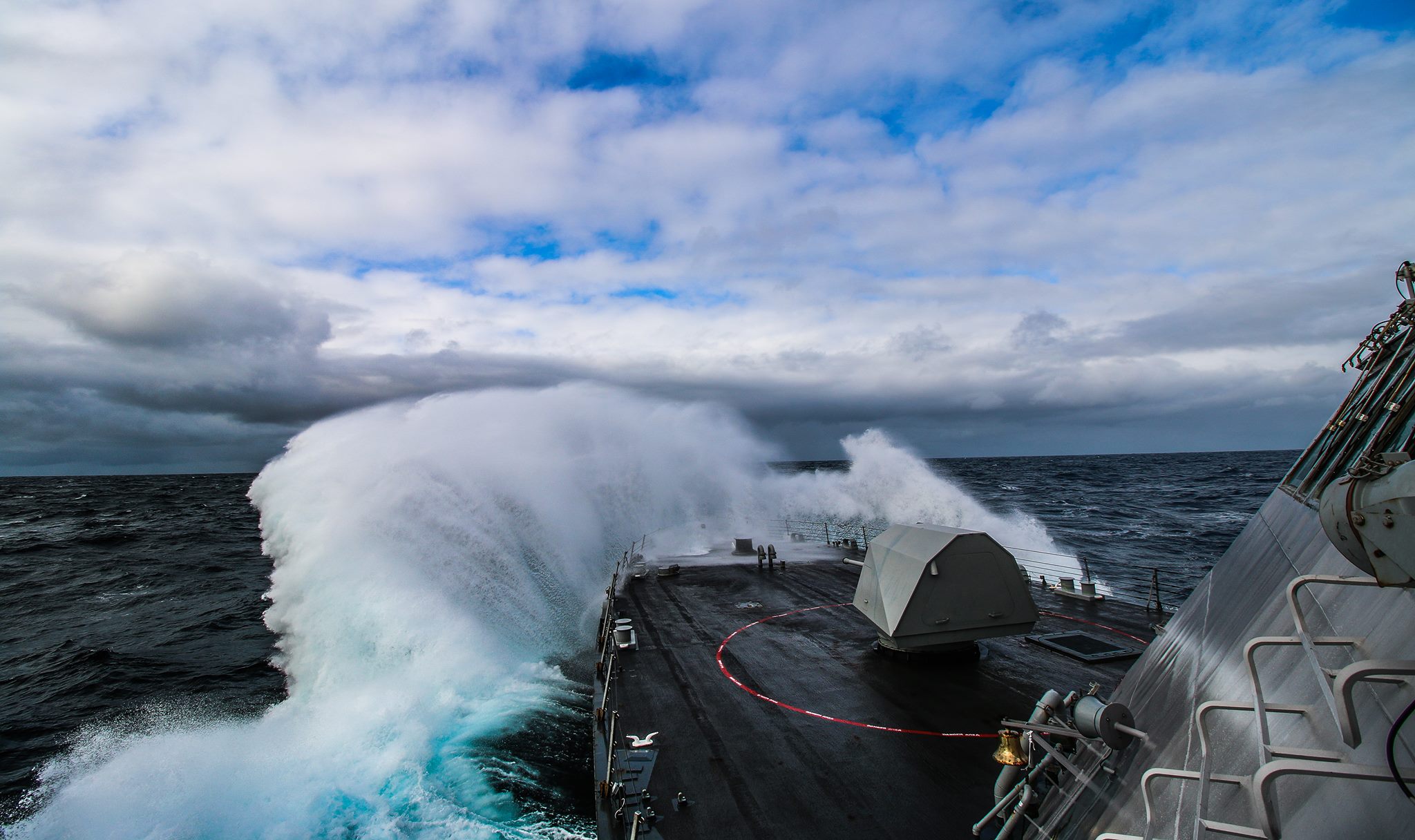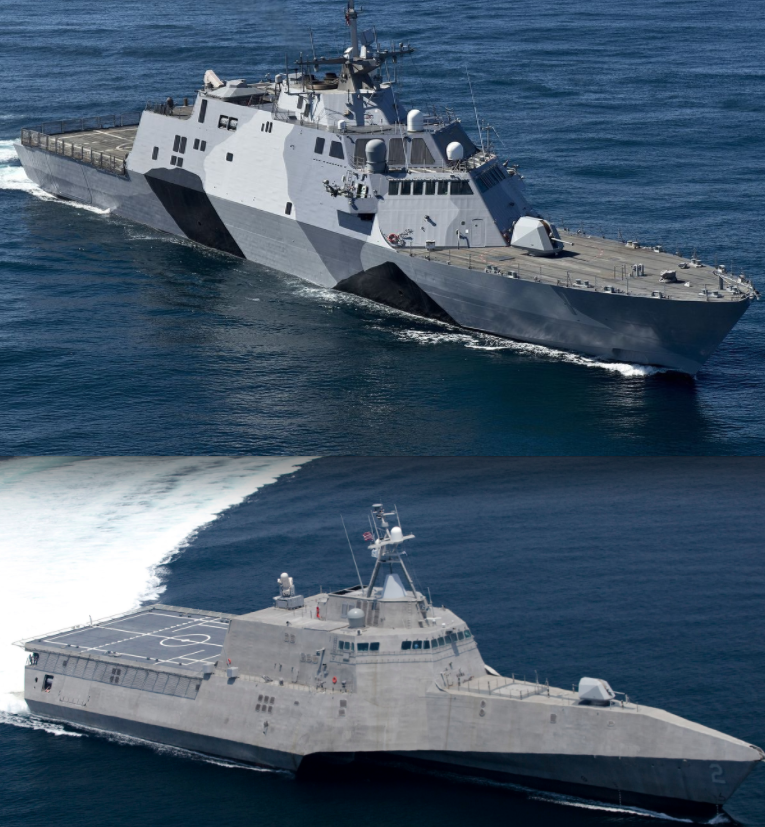
The Navy held an industry day for companies interested in participating in the frigate program, walking them through what is already decided about the future ship program and what decisions are pending industry feedback.
The guided-missile frigate program, FFG(X), is the Navy’s latest iteration of the small surface combatant program, which was first filled by the Littoral Combat Ship and then subsequently by the LCS-based frigate (FF), which would be up-gunned, up-armored and multi-mission compared to the LCS.
The FFG(X) program, announced earlier this year, will take the best of the LCS and LCS-based frigate ideas – multi-mission design, a reliance on unmanned vehicles in all domains to increase range, a smaller design to reduce cost and increase access to global ports compared to the larger surface combatants – while adding features such as vertical-launched missiles and more powerful radars, the service says.
According to the Navy’s industry day presentation slides, obtained by USNI News, industry will have until Aug. 24 to respond to the Navy’s request for information (RFI), released two weeks ago. The Navy will then enter a conceptual design phase to help take existing ship designs, called parent designs, and modify them to meet Navy requirements. The request for proposals (RFP) for the conceptual design contracts will provide system specifications and government furnished information (GFI), and conceptual design contracts will be awarded in calendar year 2018 ahead of a Fiscal Year 2020 detail design and construction contract.
Senate Armed Services Committee chairman and outspoken LCS critic Sen. John McCain (R-Ariz.) said he was “cautiously optimistic” about the new frigate program after reading the July 10 RFI.
However, in a SASC seapower subcommittee hearing this week, leading voices in the naval analysis community expressed concerns about the Navy’s approach going forward.
Center for Strategic and Budgetary Assessments senior fellow Bryan Clark said during the hearing that he worried the Navy had begun this process with too many details left undecided, and said that the Navy should be able to better determine what it wants without first requiring industry feedback.
“I think what it does is it opens up the aperture too much in terms of what that future frigate could be. It makes it seem like it could be anything from a ship that’s only able to do surface warfare and [intelligence, surveillance and reconnaissance] missions in support of distributed lethality, the Navy’s new surface concept. It could be from anything from that, which is a relatively low-end ship or less capable ship, all the way up to a frigate that can do air defense for another ship and do anti-submarine warfare,” Clark said towards the end of the hearing.
“And I think the Navy needs to, instead of opening a wide aperture and seeing what comes in, make some choices about what they need the ship to do – and it needs to be a more capable ship that’s able to do multiple missions. So, it needs to be able to do anti-submarine warfare and air defense, and surface warfare, all three of them, all at about the same time. So, it needs to be a multi-mission ship and not something that’s single mission or a dual mission ship like the RFI implies.”

The industry day slides state that the RFI was meant to help the Navy “understand industry’s parent designs and their ability to integrate both the warfare system elements and the threshold requirements into the new FFG(X) design,” and to “understand the drivers in non-recurring engineering, recurring engineering, production schedule, and operations and supports costs,” before making certain decisions.
The RFI clearly outlines what anti-submarine warfare and surface warfare capabilities the FFG(X) will have to have, listing various systems and weapons the FFG(X) must include. The extent of its anti-air capability is less clear, with the RFI posing questions to industry about how to incorporate Vertical Launching System cells into the ship design.
Jerry Hendrix, senior fellow and director of the defense strategies and assessments program at the Center for a New American Security, said at the Tuesday hearing that, opposite of Clark’s concern, he worried too much emphasis was being placed on the addition of VLS cells and anti-air warfare capability.
“I’m a little concerned about the emphasis on the air defense factor in this. I believe that the ship should provide self-air defense. But, we … have been buying excess capacity of air defense in the [Arleigh Burke class of guided-missile destroyers] for a number of years. Where we have a real deficit is anti-surface and anti-submarine warfare. And, any time that you cause a ship or require a ship to be good at all things, you’re going to drive up the cost factor on this, and I think that there’s a certain sweet spot on costs that if you exceed that – and by that, I look generally in the $700 million to $850 million range per unit – if you exceed that by adding in air defense capability, certainly we start edging over $1 billion per copy. And, at that point in time, we’ll find ourselves in argument which is to the extent of, shouldn’t we just buy some more Burkes? We really need something that we can buy in high enough numbers, so we can drive up that portion of the fleet. We talk about the need for 52 small surface combatants. Currently, we consider the LCS to be part of that 52. I actually think that number is higher, that you need something in the 70 to 75 range on small surface combatants to be able to fill out the requirements from the combatant commanders around the world. And I would like to see this to be a robust ASW, anti-surface design with a 6,000-mile range. I think that that’s a good starting point.”
On the 6,000-mile range issue, the RFI notes the “minimum distance the ship can sail without replenishment when using all of its burnable fuel” is 3,000 nautical miles while sailing at 16 knots. Hendrix told the SASC subcommittee that “given the reserve fuel requirements, because we’ve never run the ships all the way down to zero, we always want to keep fuel for ballast and emergencies, that would actually limit that ship to have to at least take one refueling for even a transatlantic convoy escort. It would seem to me that any type of ship that’s built, and it’s written into the document, needs to be able to do [anti-surface warfare], anti-submarine warfare and convoy escort, that it ought to be able to do convoy escort without having to peel off and hit the tanker on the way over,” he said.
“So it struck me that something in the 4,500- to 6,000-mile range ought to be, sort of, a walking in the door minimum, and the higher the better in order for it to give the most independent steaming out of it.”
According to the industry day slides, the FFG(X) will: supplement the fleet’s existing undersea and surface warfare capabilities, relieve cruisers and destroyers from non-combat duties, host unmanned systems that can penetrate and operate in contested environments, conduct over-the-horizon anti-ship missile operations, escort logistics ships, provide electromagnetic information exploitation capabilities and intelligence collection, and more.





